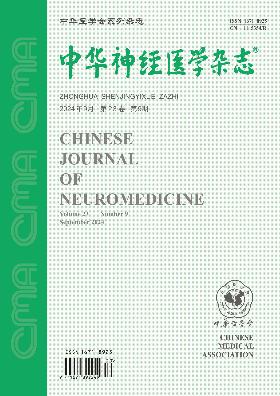Correlation of cerebral microbleeds with intracranial aneurysm rupture and hemorrhage
Q4 Medicine
引用次数: 0
Abstract
Objective To evaluate the effect of cerebral microbleeds (CMBs) on intracranial aneurysm rupture and hemorrhage. Methods A total of 2023 patients with intracranial single aneurysms (944 un-ruptured aneurysms and 1029 ruptured aneurysms) were enrolled in our study. The 3D-DSA was applied to all patients to evaluate the aneurysm sizes, locations, and morphous features, and to confirm the presence of A1 dominance and variations of Circle of Willis; moreover, aspect ratio (AR), size ratio (SR) and aneurismal inclination angle were measured. The presence of CMBs identified by T2-weighted gradient-recalled-echo sequence on magnetic resonance imaging (MRI) was evaluated; the clinical data of combined with/without CMBs patients were compared. Ninety-two untreated intracranial aneurysms patients combined with CMBs were followed up to evaluate the incubation periods of CMBs-related intracranial aneurysm rupture and hemorrhage; the clinical data of patients with un-ruptured aneurysms and ruptured aneurysms were compared; the risk factors of intracranial aneurysm rupture and hemorrhage were analyzed by univariate and multivariate Logistic regression analyses. Results CMBs confirmed by MR imaging were presented in 158 patients, with 7.81% incidence rate (158/2023). Age, proportion of smokers, aneurysm inclination Angle, SR, narrow neck, irregular aneurysm shape, proportion of rupture and hemorrhage, aneurysm sites, and hypertension showed significant differences between patients without CMBs and patients with CMBs (P<0.05). In the untreated intracranial aneurysms patients combined with CMBs, 27 had intracranial aneurysm rupture and 65 did not appear intracranial aneurysm rupture; the rupture time was 3-46 months, with an average of (15.07±10.76) months. As compared with the un-ruptured group, the ruptured group had a statistically higher proportion of patients with irregular aneurysm morphology (P<0.05). Univariate analysis showed that CMBs, female, age, aneurysm size, aneurysm morphology, ICA and ACA aneurysms, AR, variations of Circle of Willis, hypertension grading II and III, diabetes mellitus with fasting blood glucose≤6.0 mmol/L, hyperlipidemia, coronary heart disease, and drinking alcohol were important factors affecting intracranial aneurysm rupture, and the differences were statistically significant (P<0.05). Multivariate Logistic regression analysis showed that CMB was an independent risk factor for intracranial aneurysm rupture and hemorrhage; as compared with patients without CMBs, patients with CMBs had a 1.75 fold increased risk of aneurysm rupture. Conclusions Patients with intracranial aneurysms with older age, smaller aneurysm inclination Angle and larger SR are more likely to be associated with CMBs. Intracranial aneurysms with CMBs patients with irregular morphology are prone to have rupture and hemorrhage. CMBs is an independent risk factor for intracranial aneurysm rupture and hemorrhage. Key words: Intracranial aneurysm; Cerebral microbleed; Risk factor; Rupture and hemorrhage脑微出血与颅内动脉瘤破裂出血的相关性
目的探讨脑微出血(CMBs)在颅内动脉瘤破裂出血中的作用。方法选取2023例颅内单一动脉瘤患者,其中未破裂动脉瘤944例,破裂动脉瘤1029例。对所有患者应用3D-DSA评估动脉瘤的大小、位置和形态特征,并确认A1优势的存在和威利斯圈的变异;测量了长径比(AR)、尺寸比(SR)和动脉瘤倾角。评估磁共振成像(MRI)上t2加权梯度回忆回声序列识别的CMBs的存在;比较合并/不合并CMBs患者的临床资料。对92例未经治疗的颅内动脉瘤合并CMBs患者进行随访,评估CMBs相关颅内动脉瘤破裂出血的潜伏期;比较未破裂动脉瘤与破裂动脉瘤患者的临床资料;采用单因素和多因素Logistic回归分析颅内动脉瘤破裂出血的危险因素。结果mri证实的CMBs 158例,发病率为7.81%(158/2023)。年龄、吸烟者比例、动脉瘤倾角、SR、颈部狭窄、动脉瘤形状不规则、破裂出血比例、动脉瘤部位、高血压在无CMBs患者和有CMBs患者之间差异均有统计学意义(P<0.05)。在未治疗的颅内动脉瘤合并CMBs患者中,27例出现颅内动脉瘤破裂,65例未出现颅内动脉瘤破裂;破裂时间3 ~ 46个月,平均(15.07±10.76)个月。与未破裂组相比,破裂组动脉瘤形态不规则的比例有统计学意义(P<0.05)。单因素分析显示,CMBs、女性、年龄、动脉瘤大小、动脉瘤形态、ICA和ACA动脉瘤、AR、Willis环变异、高血压II级和III级、糖尿病并空腹血糖≤6.0 mmol/L、高脂血症、冠心病、饮酒是影响颅内动脉瘤破裂的重要因素,差异均有统计学意义(P<0.05)。多因素Logistic回归分析显示CMB是颅内动脉瘤破裂出血的独立危险因素;与没有CMBs的患者相比,CMBs患者动脉瘤破裂的风险增加了1.75倍。结论年龄越大、动脉瘤倾角越小、SR越大的颅内动脉瘤患者更易发生CMBs。颅内动脉瘤合并CMBs患者形态不规则,易发生破裂出血。CMBs是颅内动脉瘤破裂出血的独立危险因素。关键词:颅内动脉瘤;脑microbleed;风险因素;破裂和出血
本文章由计算机程序翻译,如有差异,请以英文原文为准。
求助全文
约1分钟内获得全文
求助全文
来源期刊

中华神经医学杂志
Psychology-Neuropsychology and Physiological Psychology
CiteScore
0.30
自引率
0.00%
发文量
6272
期刊介绍:
 求助内容:
求助内容: 应助结果提醒方式:
应助结果提醒方式:


